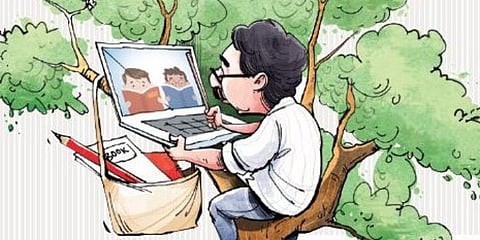

KOLKATA: The Covid-19 pandemic has taught us lessons in reality. Begin it from school education, the online version of dispensing primary and secondary education. A spirited teacher in a remote village in Bankura district of West Bengal has set up his workstation on a tree to get proper network connection for conducting online classes.
“We have network issues in our village. It is not available at my home. I explored and climbed a tree to find the uninterrupted network. I take classes from 10 am to 4.30 pm. I leave home with water bottles and food before going to my treetop workspace,” said Subrata Pati, the teacher.
With classes suspended in West Bengal along with the rest of the country due to Covid-19, educationists have raised questions on the efficacy of online classes, considering the students’ access to computers and compatible internet services.
An analysis of the report of the National Sample Survey (NSS) office in 2019 by Pratichi, a trust working on education and health, reveals only 9% of the households in the state have computers. For online classes, teachers and students must have either a smartphone with high-speed net connectivity or a broadband connected computer.
The analysis of the NSS data reveals that in Bengal, which is lagging behind Kerala, Maharashtra and Gujarat, only 3.33% families living in rural pockets have computers. The figure is 23.01% in urban areas.
“In rural Bengal, students have access to schools, but having a smartphone in their family is still considered a dream. If a family has a smartphone, it is for the earning member of the household.
Besides, most of them keep their internet data usage restricted within one GB per month, which is inadequate to participate in online exercise,” said Dr Bishnupriya Dutta Gupta, a professor of political science. Soumen Konar, the headmaster of Krishnapur High School in East Burdwan district, narrated how his initiative to launch online classes proved futile. “In April, we decided to engage 150 students of Class IX and X in online classes.
Initially, 80 students agreed, but the attendance dropped to 50 within a month. Only 15 students are now left availing of the online facility,” he said. Bishnupriya found that online classes are hardly leaving any impact on students from underprivileged households.
“With an ailing grandmother or grandfather, two siblings and parents, a student of a family living in 12 by 14 feet single-room accommodation can hardly focus when teachers lecture during online classes,” she said. The Students Federation of India (SFI), the student wing of the CPI(M), has started a survey to elicit views of general students about the efficacy of online classes. It has aimed to reach at least 5,000 students across the state.